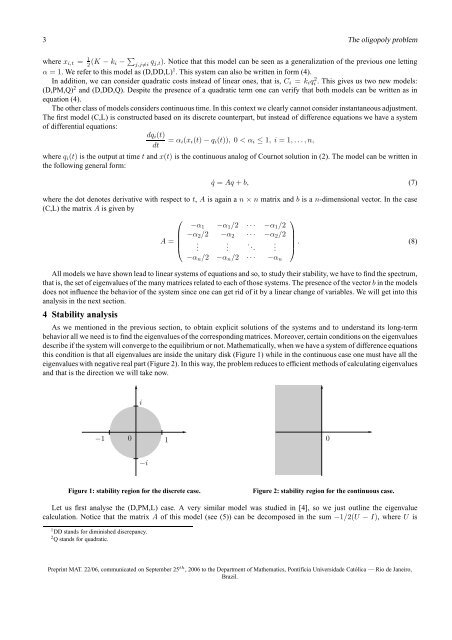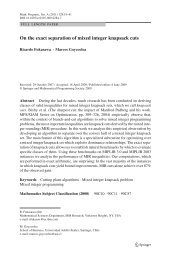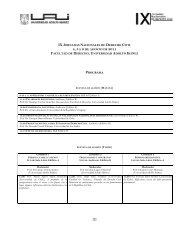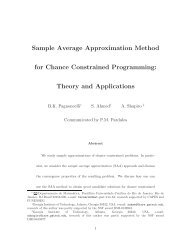Stability analysis of the oligopoly problem and variations Bernardo ...
Stability analysis of the oligopoly problem and variations Bernardo ...
Stability analysis of the oligopoly problem and variations Bernardo ...
You also want an ePaper? Increase the reach of your titles
YUMPU automatically turns print PDFs into web optimized ePapers that Google loves.
3 The <strong>oligopoly</strong> <strong>problem</strong><br />
where x i,t = 1 2 (K − k i − ∑ j,j≠i q j,t). Notice that this model can be seen as a generalization <strong>of</strong> <strong>the</strong> previous one letting<br />
α = 1. We refer to this model as (D,DD,L) 1 . This system can also be written in form (4).<br />
In addition, we can consider quadratic costs instead <strong>of</strong> linear ones, that is, C i = k i qi 2 . This gives us two new models:<br />
(D,PM,Q) 2 <strong>and</strong> (D,DD,Q). Despite <strong>the</strong> presence <strong>of</strong> a quadratic term one can verify that both models can be written as in<br />
equation (4).<br />
The o<strong>the</strong>r class <strong>of</strong> models considers continuous time. In this context we clearly cannot consider instantaneous adjustment.<br />
The first model (C,L) is constructed based on its discrete counterpart, but instead <strong>of</strong> difference equations we have a system<br />
<strong>of</strong> differential equations:<br />
dq i (t)<br />
= α i (x i (t) − q i (t)), 0 < α i ≤ 1, i = 1, . . .,n,<br />
dt<br />
where q i (t) is <strong>the</strong> output at time t <strong>and</strong> x(t) is <strong>the</strong> continuous analog <strong>of</strong> Cournot solution in (2). The model can be written in<br />
<strong>the</strong> following general form:<br />
˙q = Aq + b, (7)<br />
where <strong>the</strong> dot denotes derivative with respect to t, A is again a n × n matrix <strong>and</strong> b is a n-dimensional vector. In <strong>the</strong> case<br />
(C,L) <strong>the</strong> matrix A is given by<br />
⎛<br />
⎞<br />
−α 1 −α 1 /2 · · · −α 1 /2<br />
−α 2 /2 −α 2 · · · −α 2 /2<br />
A = ⎜ . .<br />
⎝<br />
.<br />
. . ..<br />
. ⎟<br />
. ⎠ . (8)<br />
−α n /2 −α n /2 · · · −α n<br />
All models we have shown lead to linear systems <strong>of</strong> equations <strong>and</strong> so, to study <strong>the</strong>ir stability, we have to find <strong>the</strong> spectrum,<br />
that is, <strong>the</strong> set <strong>of</strong> eigenvalues <strong>of</strong> <strong>the</strong> many matrices related to each <strong>of</strong> those systems. The presence <strong>of</strong> <strong>the</strong> vector b in <strong>the</strong> models<br />
does not influence <strong>the</strong> behavior <strong>of</strong> <strong>the</strong> system since one can get rid <strong>of</strong> it by a linear change <strong>of</strong> variables. We will get into this<br />
<strong>analysis</strong> in <strong>the</strong> next section.<br />
4 <strong>Stability</strong> <strong>analysis</strong><br />
As we mentioned in <strong>the</strong> previous section, to obtain explicit solutions <strong>of</strong> <strong>the</strong> systems <strong>and</strong> to underst<strong>and</strong> its long-term<br />
behavior all we need is to find <strong>the</strong> eigenvalues <strong>of</strong> <strong>the</strong> corresponding matrices. Moreover, certain conditions on <strong>the</strong> eigenvalues<br />
describe if <strong>the</strong> system will converge to <strong>the</strong> equilibrium or not. Ma<strong>the</strong>matically, when we have a system <strong>of</strong> difference equations<br />
this condition is that all eigenvalues are inside <strong>the</strong> unitary disk (Figure 1) while in <strong>the</strong> continuous case one must have all <strong>the</strong><br />
eigenvalues with negative real part (Figure 2). In this way, <strong>the</strong> <strong>problem</strong> reduces to efficient methods <strong>of</strong> calculating eigenvalues<br />
<strong>and</strong> that is <strong>the</strong> direction we will take now.<br />
i<br />
−1<br />
0<br />
1<br />
0<br />
−i<br />
Figure 1: stability region for <strong>the</strong> discrete case.<br />
Figure 2: stability region for <strong>the</strong> continuous case.<br />
Let us first analyse <strong>the</strong> (D,PM,L) case. A very similar model was studied in [4], so we just outline <strong>the</strong> eigenvalue<br />
calculation. Notice that <strong>the</strong> matrix A <strong>of</strong> this model (see (5)) can be decomposed in <strong>the</strong> sum −1/2(U − I), where U is<br />
1 DD st<strong>and</strong>s for diminished discrepancy.<br />
2 Q st<strong>and</strong>s for quadratic.<br />
Preprint MAT. 22/06, communicated on September 25 th , 2006 to <strong>the</strong> Department <strong>of</strong> Ma<strong>the</strong>matics, Pontifícia Universidade Católica — Rio de Janeiro,<br />
Brazil.

















